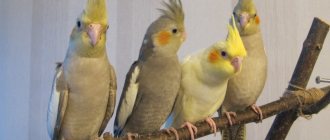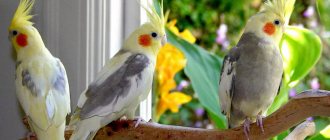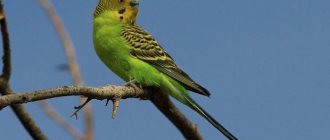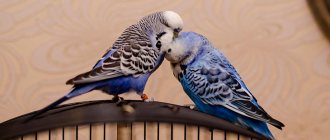How can a bird adapt to a new place?
If the cockatiel trembles and cackles in a new place, he is scared. Don't create stressful situations. He is tense and afraid of literally everything: slamming, rattling doors, barking dogs, crying children. At first, you need to take care of how to establish contact with the parrot.
First you need to create conditions that are comfortable for the bird:
- Place the cage in a quiet place.
- Protect from exposure to TV and radio.
- Restrict access to households and pets.
- Warn not to look into the cockatiel's cage unnecessarily. Approach it only to add food and change water.
- Provide the bird with everything it needs.
In this mode, the bird will spend several weeks looking closely and getting used to its new home. If possible, the same person should talk to and look after him. This way the parrot will recognize and remember its owner, in his presence it will feel protected and will not show a bad character.
Who is easier to train: a chick or an adult bird?
Corella parrots are unique birds common in Australia. The ability for long flights, bright unusual plumage, and the ability to reproduce well in captivity make the birds of this breed special.
Important! The cockatiel's colors change during the first year, after which the bird acquires a permanent coloration for life.
The owner will be especially lucky if the Corella parrot came to him straight from his native nest and has not yet had time to mature. It is these birds that are most easily tamed, amenable to training, more willing to make contact with their owner, and try to imitate him in many ways. With this in mind, it is best to begin taming your cockatiel at as early an age as possible.
If the owner has hatched cockatiel chicks, then he has the opportunity almost from birth to begin raising these birds, because the person will have to feed them (especially if the mother abandoned the weakened babies), pick them up (the chicks are completely blind, do not have the strength to move independently ). All this will contribute to the absence of fear in parrots of humans and to more willing contact with them in the future, when the birds leave their native nest.
Learn how to care for cockatiels and cockatiel chicks at home.
When raising a cockatiel chick without human intervention and making first contact with humans at a more mature age, the bird will remain wild for a long time. To mitigate this condition, it is recommended to appear more often in the eyes of the chicks while they are in their native nest, and at least in some way take part in their upbringing.
The process of taming birds is also influenced by the experience of previous communication with a person, and if it is filled with negative memories, then it will be very difficult to start trusting again; this process can take from several weeks to many years.
Birds will remain aggressive, capable of unpredictable attacks and bites. And then you need to slowly and systematically do everything in order to win the trust of the cockatiel, because each of these birds has personal experience and a unique character that require a special approach, and you also need to take into account that these parrots, especially in adulthood, are afraid of hands , and therefore the process of taming them is quite a difficult task. But if a person copes with it, he will receive a faithful and gentle friend for many years.
Communication and tactile contact
Patience, affection and attention will allow the bird to become a full-fledged member of the new family. In any situation, if it is not clear how to calm the parrot, you need to remain calm yourself. You cannot shout, hit the cage with your hand, or get irritated.
To establish contact at first, try to spend all your free time near your pet. You can talk to him affectionately, quietly sing melodic songs, treat him with fruit. This is known to always work.
If the cockatiel is trembling and clucking, you need to calm him down in a quiet, gentle voice. After a week, the bird will get used to the presence of the owner and will calmly react to his appearance. The behavior of cockatiels often depends on the situation in the house. With calm owners, the bird is also cheerful and content.
As soon as the bird stops being nervous about the presence of a person near its home, then you can try to accustom it to hands. First, they try to hand feed her, sticking her palm with food into the cage. If the parrot tries to bite, you need to remove the treat and strictly say “No,” you can gently click on the beak. Over time, he will understand that he should not do this.
At the same time, you should not wear protective gloves on your hands - they will scare away the pet even more.
Taming with food
The use of food as a way to accustom oneself to hands can be started when the bird calmly accepts the appearance of a person.
Let's highlight the individual stages:
- When feeding, open the cage more often and clean up the mess. Place new toys. The parrot should be waiting for you.
- You can give your pet delicious pieces of fruit.
- If the bird is no longer afraid, then put the yummy food on your hand and freeze. Wait for the parrot to take the treat. Don't rush. You cannot force a parrot to take food by force. The desire to try a tasty piece can overcome fear.
- When your pet gets used to taking treats from your hand, start placing the treat on your open palm away from the edge. Watch the parrot - if it bites, stretch out the time.
- When the bird stops being afraid and calmly begins to take food from your hand and sit on your palm, you can move on to the next stage.
The parrot loves to play with shiny toys. This property can be used for taming.
How to avoid bird bites
The pet hisses and shakes when it wants to protect its home. Perhaps it is too early to accustom him to holding hands. But it’s time to ask how to properly wean timid cockatiels from biting. First of all, natural causes that cause aggressive behavior are excluded: molting, diseases, mating season. If everything is in order, the cockatiel parrot is taught to behave calmly.
What to do in this case:
- Teach to understand the “no” command by clicking on the beak or cage to attract attention.
- If the bird is ready to attack, you can distract it with a bright toy. Find out why your cockatiel is acting aggressively: he is afraid or he has negative experiences with people.
- You can spray water on it if other methods do not help.
But when you hear the cockatiel creaking its beak, rest assured: he is used to the house and is happy. Experienced poultry keepers admit: this is the best sound you can hear from a pet.
What should you not do during the process?
Unlike budgerigars, cockatiels are extremely easy to tame, but failure to follow some recommendations can lead to the fact that at best it will not be possible to tame a parrot, and at worst, the bird can be injured or instill distrust in humans for the rest of its life .
Thus, some experienced cockatiel breeders talk about one strange, but supposedly “effective” method: regardless of the degree of trust between you and the bird, you just need to catch the cockatiel in a cage and lightly press the parrot on the stomach, as a result of which the bird will reflexively grab your palm and sit on it for a while.
Obviously, this method can lead to injury to the parrot; moreover, ornithologists say: the mechanism of action of this method is not clear, and the consequences for the health of the bird with such methods in the future may be unpredictable.
Also, when taming a cockatiel, you should absolutely not :
- Clean the cage in the first week of the parrot's stay in it: he must get used to the new territory and make sure that this is his “comfort zone”, where no one will disturb him.
- Make sudden movements with your hands and raise your voice, especially in the first stages.
- Start taming the hand on the very first day - it is better to give the parrot a couple of days to adapt.
- Letting a cockatiel that is unaccustomed to holding hands out of a cage in the hope that the parrot will get used to it on its own: in such cases, many cockatiels get injured and die , because, being unaccustomed to people and sounds, the birds begin to fight against closed windows and mirrors.
Whatever you do, your movements should be smooth, careful, and your voice should be calm and quiet, but confident. This will contribute to the speedy taming of the cockatiel.
How to deal with loud screaming
In the wild, parrots make all sorts of loud sounds without caring about those around them. The apartment cockatiel also likes to scream, but this does not always suit the owners. When purchasing, few people take this nuance into account. Only when faced with a sharp and unpleasant cry from a pet does the owner look for a way to quickly wean the cockatiel bird from screaming.
There are several effective ways to cope with screaming:
- Buy him a pair. Together, the birds feel more confident, they have no time to be bored, they are busy with each other.
- Play melodious music quietly. This calms Corella down. He even dances.
- Corella yells if people yell at him. He is a good imitator, so you need to speak to him quietly and gently.
- Check the feeder and drinker. Perhaps the bird is just hungry, and everyone is only concerned with how to stop it from screaming.
- In the evening, you can simply send a wild cockatiel to bed by turning off the light.
By this, the owner demonstrates that the household does not intend to listen to wild screams. Over time, the pet will understand that this is not worth doing.
Bird behavior depends on productive sleep
Excitability is directly related to how long the harmful cockatiel sleeps. For normal functioning, he needs 10 hours of quiet, deep sleep.
When a cockatiel sleeps, the following rules should be observed:
- Turn off the radio and TV during daytime naps.
- Cover your pet's cage while sleeping at night to prevent light and sounds from waking him up.
- Protect the bird from harsh sounds.
If the bird gets a full 10-hour sleep, you won’t have to wonder why the parrot is lethargic or excitable in the morning.
If there are children in the house
Kids rejoice at the appearance of a colorful pet in the house, but there are a number of rules that parents should teach their children. It is important to properly arrange a home where there are birds and a small child.
To avoid any troubles, children are explained what they should absolutely not do:
- Screaming near the cage. Tell your child why the parrot is afraid of sharp sounds.
- Play with the bird like a toy: flapping, pulling out feathers, strangling.
- Open the cage without adult permission. Explain that the bird flies well and can slip out of the open window.
- You can't have a cockatiel and your small child living in the same room.
Also, parents should show by their own example how to calm excited cockatiels and how to care for them. You can train the bird together and show your child in a playful way how to wean the bird from being afraid of people.
If the parrot flies away
A bird owner may leave a window or door open and not notice the cockatiel flying away. We need to try to get him back. You need to understand that the pet is not far away. He, scared and confused, hides in a tree in the yard.
To attract the attention of a fugitive, do the following:
- Play a recording of the chirping of parrots of his species or melodious music on the windowsill.
- They place a feeder with his favorite food on the window.
- If there are other birds in the house, take them outside in a cage.
- You need to walk along the nearest streets and call your pet. Perhaps he will respond.
Not always, if a cockatiel parrot has flown away, it is useless to look for it. But the likelihood that, under the influence of hunger, he will find his way to another house is high. The death of the bird is not excluded.
Winning the heart of a cockatiel is not difficult if you work at it every day. The main tool for creating a friendly relationship with your pet is love and patience. Over time, the nimble bird will become a full member of the family. Her sweet talk and awkward dances will not let you get bored even on the gloomiest days. And remember: let your cockatiel squeak his beak more often.
Adult cockatiels, undomesticated: help newbies!
Good afternoon Please help with advice for newbies!
Story
We took two adult cockatiels from our hands. From the stories of the former owners, they found out that the birds were given away because the children had lost interest in them and did not want to care for them anymore. During their two years of life, the birds were never (!) released from the cage. The birds never had a bath (!). Moreover, the birds lived for two years in a cramped cage (!). According to the owners, the birds are 2 years old and are male and female. They never took care of birds; the parrots did not react in any way to the nicknames given by their owners, although Zhorik (the male) initially already knew a couple of phrases, but then stopped giving them out.
In short, we decided to take these poor fellows. We felt sorry for them. They gave us their cage, food, and supplements as a dowry.
So, exactly the day has passed that we have.
First, we brought new friends into the room, to their permanent future place - an ordinary living room in a private house. They only sleep here. The TV doesn't make noise. Nobody speaks loudly here. We talked with them a little and left them alone so that the birds calmed down.
We remodeled the old cage a bit; in addition to being small, it seemed to us cluttered with completely unnecessary perches, swings, and some kind of sticks for such an area. As a result, the birds began to climb a lot and were able to straighten their wings normally. We treated the birds to an apple.
Their routine is this: from 22.00 to 9.00 we cover them with a cloth, they sleep, then they spend the whole day actively (as far as one can call it), in the morning you can hear the male singing, quite beautiful, and then a wild trash of screams begins, for hours before 14.00. After lunch they have a quiet time, they become silent and doze off. Then they spend their evening less actively, but quite loudly. They like to respond to crows and tits, and also to local cats and dogs, and the alarm causes a whole concert!)
The new friends were named Klyuvik and Kiki.
What we observed during the day:
1. Birds often crest and tremble, the female has a place on her head where the feathers seem to be torn out, it does not bleed, according to the old owners, this is the efforts of the male.
2. They seem to be at odds with each other - they bite and peck at each other, but then they calm down and talk, there are no cute hugs and all that other stuff (like in the pictures);
3. They don’t come to hand: the male hisses and opens his wings, as if attacking; the female is not so timid and more calm, but avoids hands;
4. Behavior: the male is active, chirps, pecks the female and chases around the cage, at first he stood between us and the female, as if protecting her;
5. The most important thing: they eat well, drink fresh water, poop like horses, it seems normal;
6. Birds do not leave an open cage.
7. The purchased caged gaming device caused fear in the birds, they hid in a corner, and the device was removed.
What we plan to do:
1. Visit the veterinarian, this will be another stress for the birds, which you don’t want at all, they have begun to get used to it.
2. It’s a little more difficult with the new cage, since it’s unlikely that we will be able to transplant them in the near future due to shyness, we decided to simply extend the top of the cage (the arms are in place) so that temporary housing and adaptation time for them would be more comfortable in a larger space .
3. Buy a hanging bathing suit, a stone for beaks, make a house for the nest.
I would like to hear advice from experienced people.
Which mistakes?
Is it possible to judge by color that our guys are definitely not same-sex?
What should be the first steps towards bird adaptation and domestication?
Is it possible that what the owners say is true about the female’s head?
Birds trembling and ruffling - could it be a symptom of stress?
Why do birds behave so aggressively towards each other?
How can you entertain untamed birds?











